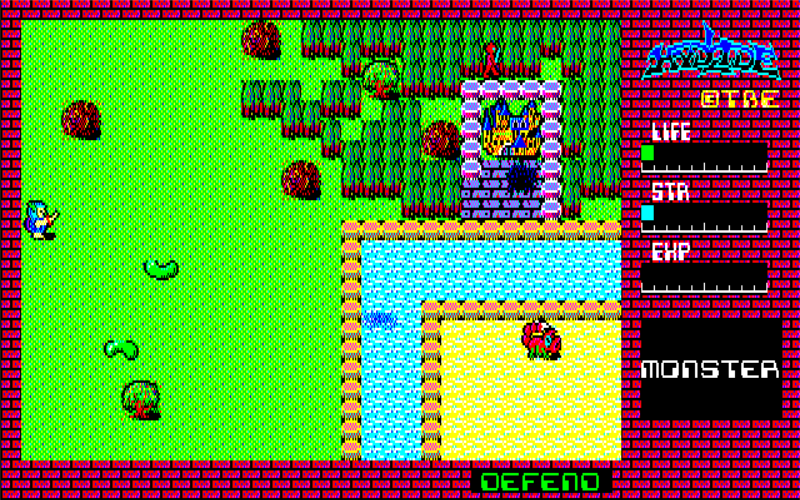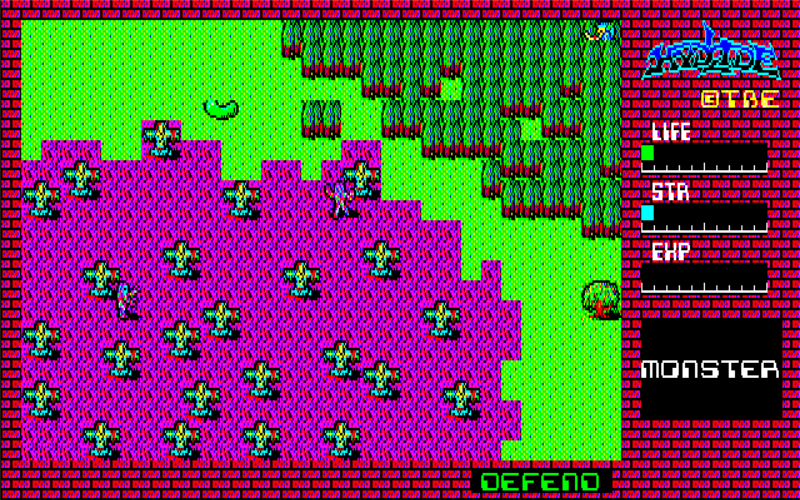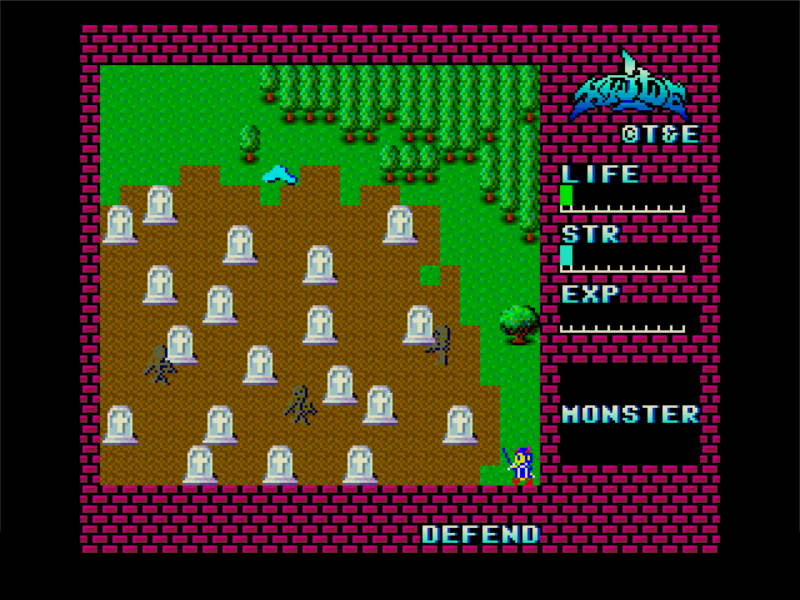A look back at 8 versions of classic action RPG Hydlide reveals how PC ports can preserve—or lose—the soul of a game
What does an "authentic" version of a game look like? Sometimes they have to change to stay the same.
Pasokon Retro is our regular look back at the early years of Japanese PC gaming, encompassing everything from specialist '80s computers to the happy days of Windows XP.

"IN OTHER DIMENSIONAL SPACE THREE JEWELS KEPT THE KINGDOM IN PEACE"
Now that's how you kick off a multi-million selling RPG. None of this "emotional storytelling" business performed by award-winning actors. No gorgeous shots of mystical locales painstakingly crafted by an entire studio's worth of artists. Just a few lines of plain text on a black background about when "A MAN CALLED JIM WHO COULD NOT ENDURE TO SEE PEOPLE TORTURED DECIDED TO EXTERMINATE THE DEVIL."
This is part of the intro to Hydlide, T&E Soft's groundbreaking "Active Role Playing Game." Back in 1984 this game didn't just set standards or raise bars, it invented them. Gaming still owes Hydlide a debt of gratitude. This was the Elden Ring of its day, an open world action RPG where half the fun lies in working out how to get somewhere and then trying to survive the journey using nothing but a sword, shield, and wit.
Its head-turning combination of ambition and freedom soon saw the game ported from its PC-88 home to just about every major computer brand Japan had for sale that decade, each new version of the game carefully adapted to fit its new home.
And this is where things get really interesting. What exactly is Hydlide when it's been endlessly pushed and pulled and tweaked to fit hardware it wasn't originally made for? What was essential enough to the core design that it had to be recreated in the port for the weaker PC-6601, even though the brightly coloured little game runs at a Lego-like resolution and can't even consistently display a double-digit quantity of colours? What does the MSX2's luxurious 128KB VRAM-enhanced take on this important work choose to keep the same, even though it had power and memory to spare?








How much would Hydlide change in a port 17 years later—would it still really be Hydlide? Perhaps if I compare enough of them I'll find the answer.
Keep up to date with the most important stories and the best deals, as picked by the PC Gamer team.
Some of it's obvious. On every format this is a real-time RPG where Jim runs straight into enemies to attack them, and recovers his health by taking a quick break in the sunlight. The overworld layout stays the same, as does the overall goal. But some of Hydlide's most important details are more subtle. The game's border had to be made of bricks, and for some reason those bricks had to be a hot pink colour. That same border had to show the game's logo in miniature form in the top-right corner, even if it ended up so small and squished it was barely recognisable.
Without a doubt the most advanced version of the game the '80s ever had... isn't Hydlide
It didn't matter if slimes looked like green jelly beans or blue blobs so long as they enthusiastically wriggled about as they moved, and the helmet Jim wore as he heroically dispatched them had to be embellished with tiny horns even when his sprite was otherwise so basic it used fewer colours than his health bar. He had to look like a hero, no matter what.
There are plenty of other details that seemed essential, but somehow the game is no less "Hydlide" if a port altered or even outright removed them. Like the game's intro, explaining exactly why Jim "TRIED TO ATTACK THE MONSTER TO REESTABLISH THE KINGDOM." The MSX version simply doesn't bother with it, and the game doesn't exactly suffer for its absence. It turns out the adventure itself really is enough. It was important that the ground by the graveyard looked different to the nearby grass, but whether that took the form of a pretty ordinary dirt brown or a sickly purple colour varied from game to game—recently disturbed graves are just as unsettling an idea as having to walk through weird ooze.
Rivers needed a visible border, but that edge being made of neat blue tiles (MSX) or rounded wooden posts (everywhere else) didn't really matter. A few monsters might not show up at all depending on the format, something else used in their place. So long as I've still got something to fight, it's close enough.

So, that's Hydlide then? Nothing more than a mixture of a few things it should and shouldn't have with a few optional extras thrown in, like a recipe list?
Yes but…no, not quite.
It was only after spending some time with the Sharp X1 version of the game that I realised what really mattered. Although this particular port appeared around the same time as all the others (1985), it took advantage of the hardware's unique ability to give programmers quick access to all the RAM, all the time to produce something truly spectacular. I'm still Jim and I'm still off to restore peace to the land through physical violence, but here the game's right-angled rivers have been replaced by more organic edges, and the rigid screen-by-screen exploration has been ditched in favour of a smooth free scrolling system. This is without a doubt the most advanced version of the game the '80s ever had.
But it isn't Hydlide. The magic's gone. Enemies here blandly mingle with other types instead of being cleanly separated by the unbreakable edge of the screen, draining areas of both the safety that comes from knowing when I'm standing in a field of weak monsters and the sudden shock of blundering my way into a screen filled with something new.
Those raggedy riverbanks deny me a clear path to follow, and are no longer the strong visual screen-long landmarks they are elsewhere.








The detail that's been gained can't match the clarity of what's been lost. Hydlide is supposed to have rules. Order that keeps the chaos confined within each screen, every new view showing me no more or less than everything I'm supposed to see. Everywhere else it played like a high-speed string of tabletop encounters, a connected sequence of tactical maps covered with a limited range of terrain type squares and a smattering of monsters. On the Sharp X1, it was just an endless field with some random enemies in it, the gaming equivalent of being able to freely look around a movie set instead of seeing all of the action through the director's lens.
At least T&E Soft only made that mistake once. The 2001 Windows remake of Hydlide upgraded the graphics once more, but returned to the familiar flip-screen wandering and striking and the unnatural right-angled corners of old. It could have easily expanded the story, introduced new mechanics, and given Jim an equipment screen or reams of new dialogue—nobody would have been surprised if a remake of a decades-old game tried to reinvent itself.
Instead it wanted to be something better—it wanted to be Hydlide.

When baby Kerry was brought home from the hospital her hand was placed on the space bar of the family Atari 400, a small act of parental nerdery that has snowballed into a lifelong passion for gaming and the sort of freelance job her school careers advisor told her she couldn't do. She's now PC Gamer's word game expert, taking on the daily Wordle puzzle to give readers a hint each and every day. Her Wordle streak is truly mighty.
Somehow Kerry managed to get away with writing regular features on old Japanese PC games, telling today's PC gamers about some of the most fascinating and influential games of the '80s and '90s.


